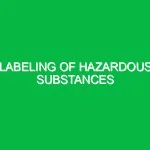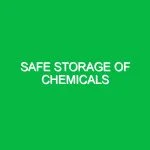In an industrial landscape where chemicals play a vital role, the potential for chemical spills is an ever-present risk. Chemical spill response is not just a regulatory requirement; it is a crucial aspect of ensuring safety, protecting the environment, and maintaining operational integrity. This article delves into the nuances of chemical spill response, its relevance in the Health, Safety, and Environment (HSE) domain, and the protocols necessary to mitigate risks associated with spills.
Understanding Chemical Spill Response
Chemical spill response refers to the procedures and actions taken to manage and mitigate the effects of a chemical spill. This can range from minor leaks to catastrophic spills that can cause significant harm to human health and the environment. In the HSE context, effective spill response is essential to minimize health risks to workers and the surrounding community while also protecting the environment from hazardous materials.
The Relevance of Chemical Spill Response in HSE
In the HSE domain, the importance of chemical spill response cannot be overstated. Industries that handle hazardous materials must have robust spill response plans in place. These plans not only fulfill legal obligations but also demonstrate a commitment to safety and environmental stewardship. Effective spill response can prevent accidents and reduce the potential for long-term environmental damage, thereby safeguarding public health and enhancing corporate reputation.
Potential Hazards and Risks Associated with Chemical Spill Response
Understanding the various hazards associated with chemical spills is crucial for developing a comprehensive response strategy. The risks can be broadly categorized into three categories: health hazards, environmental hazards, and operational hazards.
Health Hazards
Exposure to hazardous chemicals can lead to a range of health issues. For instance, inhalation of toxic vapors can result in respiratory problems, neurological damage, or even fatalities. Skin contact with hazardous substances may cause burns or allergic reactions. Additionally, chemical spills can create unsafe working conditions, increasing the likelihood of accidents and injuries. A personal anecdote I recall involves a colleague who suffered severe respiratory distress due to a benzene spill at a manufacturing facility. This incident underscored the importance of proper protective equipment and timely medical response.
Environmental Hazards
Chemical spills can have devastating effects on the environment. Contaminated water sources can harm aquatic life, disrupt ecosystems, and pose risks to human health through contaminated drinking water. Soil contamination can lead to loss of agricultural productivity and long-term ecological damage. For example, the infamous Deepwater Horizon oil spill in 2010 serves as a stark reminder of how industrial accidents can wreak havoc on marine environments and local economies.
Operational Hazards
Operational hazards arise from the disruption of normal business activities due to a spill. Beyond the immediate health and environmental concerns, a spill can lead to significant financial losses, costly cleanup operations, and potential legal liabilities. Companies may face regulatory fines and increased insurance premiums, not to mention the damage to their reputation. A well-known case involved a chemical manufacturer that faced a multi-million dollar lawsuit due to inadequate spill response measures, highlighting the financial implications of neglecting proper procedures.
Safety Precautions and Best Practices for Chemical Spill Response
To effectively manage the risks associated with chemical spills, organizations must implement safety precautions and best practices. Here are several actionable strategies that can enhance spill response efforts.
1. Develop a Comprehensive Spill Response Plan
A robust spill response plan is the backbone of any effective response strategy. This plan should outline the specific procedures for containing and cleaning up spills, the roles and responsibilities of personnel, and communication protocols. Regularly review and update the plan to incorporate lessons learned from past incidents and changes in regulations.
2. Train Employees Regularly
Training is essential in ensuring that all employees understand their roles in spill response. Conduct regular training sessions that cover spill response procedures, use of personal protective equipment (PPE), and emergency communication protocols. Simulated spill drills can help reinforce these concepts and prepare employees for real-life scenarios.
3. Invest in Personal Protective Equipment (PPE)
Providing employees with appropriate PPE can significantly reduce the risk of injury during a spill response. This includes gloves, goggles, respirators, and chemical-resistant suits, depending on the types of chemicals handled. Ensure that all equipment is regularly inspected and maintained to guarantee its effectiveness in the event of a spill.
4. Establish Communication Protocols
Clear communication is critical during a spill response. Establish protocols for reporting spills, notifying emergency services, and communicating with affected personnel. Ensure that communication equipment is readily available and functional to facilitate timely responses.
5. Conduct Regular Inspections and Maintenance
Routine inspections of storage areas, pipelines, and equipment can help identify potential issues before they lead to spills. Implement a maintenance schedule that includes checks for leaks, corrosion, and other factors that could contribute to a spill. Early detection is key to preventing spills from occurring in the first place.
6. Utilize Spill Control Materials
Stocking spill control materials such as absorbents, booms, and pads can enhance response capabilities. Ensure that these materials are easily accessible and that employees are trained in their proper use. Having the right tools on hand can significantly reduce the time it takes to contain a spill.
Regulations and Standards Governing Chemical Spill Response
Several regulations and standards govern chemical spill response, reflecting the importance of managing chemical hazards. Compliance with these regulations is not just a legal mandate; it is a moral obligation to protect human health and the environment.
1. Environmental Protection Agency (EPA)
The EPA sets forth regulations under the Clean Water Act, which mandates that facilities handling hazardous substances develop and implement spill prevention, control, and countermeasure (SPCC) plans. These plans must outline procedures for preventing spills and responding to them if they occur.
2. Occupational Safety and Health Administration (OSHA)
OSHA regulations require employers to provide a safe workplace, which includes managing chemical hazards. The Hazard Communication Standard (HCS) mandates that employers inform employees about the chemicals they work with and train them on proper handling and response procedures.
3. Local and State Regulations
In addition to federal regulations, local and state regulations may impose additional requirements for spill response. It is essential for organizations to stay informed about the specific regulations applicable to their location and industry.
Conclusion
In conclusion, chemical spill response is a critical component of health, safety, and environmental management. By understanding the potential hazards associated with chemical spills and implementing effective response strategies, organizations can protect their employees, the environment, and their bottom line. A proactive approach to spill response not only ensures compliance with regulations but also fosters a culture of safety that can prevent incidents before they occur. The stakes are high, and the need for preparedness is paramount. As industries continue to evolve, so too must our commitment to responsible chemical management and spill response.


